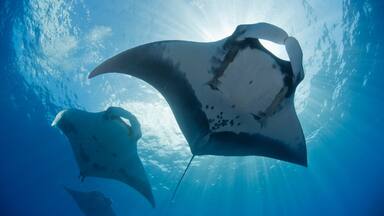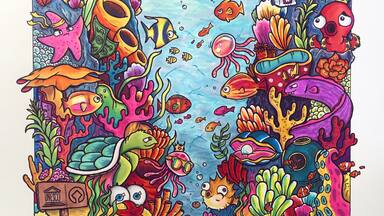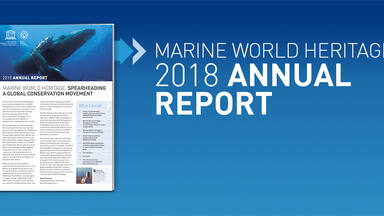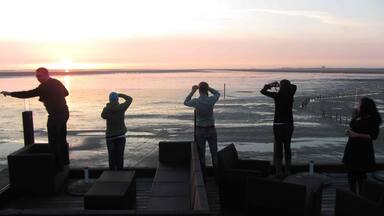St Kilda
St Kilda
This volcanic archipelago, with its spectacular landscapes, is situated off the coast of the Hebrides and comprises the islands of Hirta, Dun, Soay and Boreray. It has some of the highest cliffs in Europe, which have large colonies of rare and endangered species of birds, especially puffins and gannets. The archipelago, uninhabited since 1930, bears the evidence of more than 2,000 years of human occupation in the extreme conditions prevalent in the Hebrides. Human vestiges include built structures and field systems, the cleits and the traditional Highland stone houses. They feature the vulnerable remains of a subsistence economy based on the products of birds, agriculture and sheep farming.
Description is available under license CC-BY-SA IGO 3.0
Île de St Kilda
Cet archipel volcanique avec ses paysages spectaculaires est situé au large des côtes des Hébrides. Il comprend les îles Hirta, Dun, Soay et Boreray. C’est une des plus hautes falaises d’Europe qui possède des colonies d’espèces d’oiseaux rares en danger, dont les macareux et les fous de bassan. St. Kilda est inhabité depuis 1930, mais l’archipel conserve des traces de la présence de l’homme de plus de 2 000 ans dans les conditions extrêmes qui sont celles des Hébrides. Les vestiges humains incluent des structures bâties et de systèmes d’exploitation des terres agricoles, les cleits, ainsi que les traditionnelles maisons en pierre caractéristiques des Highlands. Ils représentent les traces fragiles d’une économie de subsistance fondée sur les produits avicoles et agricoles et l’élevage d’ovins.
Description is available under license CC-BY-SA IGO 3.0
جزيرة سانت كيلدا
يقع هذا الأرخبيل البركاني بمناظره الطبيعية الخلابة على طول شواطئ جزر هيبريد. وهو يتألف من جزر هيرتا ودان وسواي و بوريراي ويشكل إحدى أكبر الشواطئ الصخرية الاوروبية التي تشكل موطناً لأصناف من الطيور النادرة المهددة بالخطر كبطات الصخور. ورغم خلوه من السكان منذ عام 1930، حافظ هذا الأرخبيل على آثار لوجود بشري يعود الى أكثر من ألفي سنة في ظروف جزر هيبريد القاسية. وتشمل هذه الآثار البشرية مباني مشيدة وأنظمة لاستغلال الأراضي الزراعية تعرف بالعنابر، ومنازل حجرية تقليدية تتميز بها الهايلاندز، كما تجسّد آثاراً هشة لاقتصاد اكتفاء ذاتي قائم على المنتوجات المرتبطة بالطيور والزراعة وتربية الغنم.
source: UNESCO/CPE
Description is available under license CC-BY-SA IGO 3.0
圣基尔达岛
1986年,圣基尔达岛由于其自然特色和野生动物被首次列入《世界遗产名录》。今天,这里又被列为文化遗产地,成为一项综合性遗产。这片火山群岛包括4个岛屿,分别是赫塔岛、丹村岛、索厄岛和博雷岛,自1930年以来就无人居住。这里保留着人类在赫布里底群岛的极端条件下在此生活两千多年的证据。人类生活遗迹包括建筑结构、农田系统、cleits和传统的高地石屋。这些展示了当地经济易遭破坏的遗迹,这种经济建立在鸟类、农业和牧羊产品的基础之上,仅供维持生存。
source: UNESCO/CPE
Description is available under license CC-BY-SA IGO 3.0
Острова Сент-Килда
Живописный вулканический архипелаг, лежащий близ Гебридских островов, включает острова Хирта, Дан, Соуэй и Боререй. Здесь находятся высочайшие во всей Европе морские утесы, которые служат убежищем для крупных птичьих колоний, в первую очередь для тупика, северной олуши и глупыша. Архипелаг, который с 1930 г. не имеет постоянного населения, хранит следы более чем 2-тысячелетнего пребывания человека в этих суровых условиях. Здесь можно увидеть следы старых полей, сложенные из камней амбары-хранилища (cleits) и традиционные каменные дома. Все это напоминает о былом образе жизни местного населения, которое использовало перо, пух и яйца морских птиц, занималось земледелием и разведением овец. Впервые архипелаг был занесен в Список ЮНЕСКО в 1986 г., а прилегающая к нему акватория вошла в объект наследия в 2004 г., благодаря чему его общая площадь практически удвоилась. В 2005 г. объект был расширен вновь с целью включения культурных ценностей, и в связи с этим он был отнесен к культурно-природному наследию по категории «культурный ландшафт».
source: UNESCO/CPE
Description is available under license CC-BY-SA IGO 3.0
San Kilda
Este archipiélago volcánico de paisajes espectaculares, formado por las islas de Hirta, Dun, Soay y Boreray, se halla frente a las costas de las Hébridas y posee algunos de los más altos acantilados de Europa, donde viven inmensas colonias de especies poco comunes de aves marinas en peligro de extinción, en particular frailecillos y alcatraces. Despoblado desde 1930, el archipiélago de San Kilda posee vestigios que atestiguan una presencia constante del hombre en estos parajes apartados e inhóspitos de la región de las Islas Hébridas desde hace más de 2.000 años. Entre esos vestigios destacan los sistemas de explotación agrarios denominados cleits y las casas de piedra tradicionales de los Highlands, huellas frágiles de un asentamiento humano con una economía de subsistencia basada en los productos de las aves, la agricultura y la ganadería ovina.
source: UNESCO/CPE
Description is available under license CC-BY-SA IGO 3.0
セント・キルダ
source: NFUAJ
Saint Kilda
Source: unesco.nl
Outstanding Universal Value
Brief synthesis
The tiny archipelago of St Kilda, lying off the west coast of mainland Scotland, is breathtaking. Formed from the rim of an ancient volcano associated with the opening up of the North Atlantic some 65-52 million years ago, the intensely dramatic, jagged landscape of towering cliffs – some of the highest sea cliffs in Europe – and sea stacks present stark black precipitous faces plunging from steep grass-green slopes in excess of 375m. Scenically, every element appears vertical, except the smooth amphitheatre of VillageBay on Hirta with its relict historic landscape. Exposure to some of the greatest wave heights and strongest wind speeds in Europe plays a major role in shaping the coastal ecology.
With nearly one million seabirds present at the height of the breeding season, St Kilda supports the largest seabird colony in the north-east Atlantic, its size and diversity of global significance making it a seabird sanctuary without parallel in Europe. The very high bird densities that occur in this relatively small area, conditioned by the complex and different ecological niches existing in the site and the productivity of the surrounding sea, make St Kilda unique. Of particular significance are the populations of Northern Gannet, Atlantic Puffin and Northern Fulmar. The sight and sound of these myriad seabirds adds significantly to the scenic value and to the experience of the archipelago during the breeding season.
The islands’ isolation has led to two outstanding examples of remote island ecological colonisation and subsequent genetic divergence in the two endemic sub-species, the St Kilda Wren and St Kilda Fieldmouse. The feral Soay sheep, so much a feature of the landscape, represent an ancient breed, descendents of the most primitive domestic sheep found in Europe. They provide a living testament to the longevity of human occupation of St Kilda and, in addition, are a potentially significant genetic resource.
The combination of oceanic influences (proximity of deep ocean currents along the continental slope, extreme exposure to waves and oceanic swell, high water clarity) and local geology around the archipelago has created a marine environment of unparalleled richness and colour. The seabed communities are outstanding in terms of biodiversity and composition, including ‘northern’ and ‘southern’ species at the extremes of their range. The plunging underwater rock faces are festooned with sea life – a kaleidoscope of colour and form kept in constant motion by the Atlantic swell, creating an underwater landscape of breathtaking beauty. The complex ecological dynamic in the marine environment is essential to maintenance of both the terrestrial and marine biodiversity.
Overlaying the spectacular natural landscape and giving scale to it all, is a rich cultural landscape that bears exceptional testimony to millennia of human occupation. Recent research indicates that the archipelago has been occupied on and off for over 4000 years. The landscape including houses, large enclosures and cleits – unique drystone storage structures found, in their hundreds, across the islands and stacks within the archipelago – culminates in the surviving remains of the nineteenth and twentieth century cultural landscape of Village Bay. The time depth, preservation and completeness of the physical remains, provides a tangible and powerful link to the islands’ past history, its people and their way of life, a distinctive existence, shaped by the St Kildan’s response to the peculiar physical and geographic setting of the islands.
The islands provide an exceptionally well preserved and documented example of how, even in the most extreme conditions of storm-swept isolated island living, people were able to live for thousands of years from exploiting natural resources and farming. They bear physical witness to a cultural tradition that has now disappeared, namely reliance on seabird products as the main source of livelihood and sustenance, alongside subsistence farming. These age-old traditions and land uses that have so shaped the landscape, have also unquestionably contributed to its aesthetic appeal.
St Kilda represents subsistence economies everywhere – living off the resources of land and sea and changing them over time, until external pressures led to decline, and, in 1930, to the abandonment of the islands. The poignancy of the archipelago’s history, and the remarkable fossilised landscape, its outstanding and spectacular natural beauty and heritage, its isolation and remoteness, leave one in awe of nature and of the people that once lived in this spectacular and remarkable place.
Criterion (iii): St Kilda bears exceptional testimony to over two millennia of human occupation in extreme conditions.
Criterion (v): The cultural landscape of St Kilda is an outstanding example of land use resulting from a type of subsistence economy based on the products of birds, cultivating land and keeping sheep. The cultural landscape reflects age-old traditions and land uses, which have become vulnerable to change particularly after the departure of the islanders.
Criterion (vii): The scenery of the St Kilda archipelago is particularly superlative and has resulted from its volcanic origin followed by weathering and glaciation to produce a dramatic island landscape. The precipitous cliffs and sea stacks as well as its underwater scenery are concentrated in a compact group that is singularly unique.
Criterion (ix): St Kilda is unique in the very high bird densities that occur in a relatively small area, which is conditioned by the complex and different ecological niches existing in the site. There is also a complex ecological dynamic in the three marine zones present in the site that is essential to the maintenance of both marine and terrestrial biodiversity.
Criterion (x): St Kilda is one of the major sites in the North Atlantic and Europe for seabirds with over 1,000,000 birds using the island. It is particularly important for gannets, puffins and fulmars. The maritime grassland turf and underwater habitats are also significant and an integral element of the total island setting. The feral Soay sheep are also an interesting rare breed of potential genetic resource significance.
Integrity
The islands encompass exemplary and well preserved remains of the distinctive way of life that persisted in this remote area, unaltered after the St Kildans abandoned the islands. They encompass the complete fossilised cultural landscape. The natural heritage of the archipelago is the result of natural processes coupled with its long history of human occupation and, more recently, external human influences. The marine environment is largely intact.
Ownership and stewardship of the archipelago by the National Trust for Scotland, the statutory designations in place, the archipelago’s remote location, the difficulty of accessing it and human activities almost entirely centred upon Hirta, have significantly contributed to retaining the integrity of the archipelago’s heritage.
However, both natural and cultural attributes are threatened to a degree by a range of remote and local environmental and anthropogenic factors such as climate change and unsustainable tourism. Climatic conditions and coastal erosion remain the main threat to the abandoned houses, cleits and other archaeological remains across the archipelago. Large-scale off-shore developments could pose a potential threat to the pristine setting of the islands. Accidental introduction of invasive species poses a significant threat to the natural heritage; and probably the most severe potential threat to the integrity of the marine environment comes from variations in the marine ecosystem, especially the plankton, caused by climate change. Lack of strong protection of the marine environment, unsustainable fishing methods and oil spills also pose a threat to the marine environment and seabird colonies.
The modern installations, the radar base and related buildings, associated with the UK Ministry of Defence (MOD) operations on Hirta, take up a relatively small footprint, although they do still have an impact on the landscape, as do the coastal defences.
Authenticity
The challenge for conservation of the cultural landscape is to keep a balance between the principle of minimum intervention and active conservation work necessary to minimise decay, whilst keeping records of all the work that is done. With few exceptions this has meant re-using fallen materials, with little introduction of new materials. Where new materials have necessarily been required these have largely, and as far as possible, been like-for-like replacements. A representative sample of the 1400 cleits is monitored and actively maintained.
Protection and management requirements
The primary legislation that protects the archipelago and surrounding seas and their key attributes are: The Conservation (Natural Habitats. & C.) Regulations 1994, as amended; The Wildlife and Countryside Act 1981; The Land Reform Act 2003; Nature Conservation (Scotland) Act 2004; The Ancient Monuments and Archaeological Areas Act 1979; The Planning etc. (Scotland) Act 2006; and The Environmental Liability (Scotland) Regulations 2009. The Scottish Historic Environment Policy (SHEP) sets out the primary policy guidance on the protection and management of the historic environment in Scotland.
The archipelago and surrounding seas are protected by a number of national and international designations, both statutory and non-statutory. For the natural values, the property is designated as a Special Area of Conservation, Special Protection Area, National Nature Reserve, Site of Special Scientific Interest, National Scenic Area, Marine Consultation Area and Geological Conservation Review Site. For the cultural values, selected areas of Hirta are designated as Scheduled Monuments. These designations are backed up by UK, Scottish and local policies, plans and legislation.
The National Trust for Scotland (NTS), a charity, owns and manages the archipelago of St Kilda. Management is guided by a Management Plan which is approved and its implementation overseen by the major stakeholders.
Currently, the MOD has the only full time presence on the islands, although NTS and other conservation bodies/researchers are there for a significant part of the year. The current management regime is vulnerable to the withdrawal of the MOD and to resource constraints within the NTS.
Management of the cultural heritage will proceed on the basis of the minimum intervention required to sustain the attributes of the property’s Outstanding Universal Value, underpinned by the recent intensive and systematic archaeological survey of the whole archipelago, carried out by the Royal Commission on the Ancient and Historical Monuments of Scotland. Conservation of the marine environment, at present, lacks the strong protection of the terrestrial heritage, and ensuring its greater protection in the future will be critical. Management of the natural heritage is and will continue to be one of non-intervention, allowing natural processes to take their course, except where a feature of greater heritage significance is under threat.
Many of the challenges facing St Kilda and/or the NTS in its management of the archipelago -e.g. the threat of invasive species, unsustainable tourism or fishing practices, coastal erosion, etc. -are tackled through working closely with relevant stakeholders, undertaking systematic research and monitoring, providing adequate resources and implementation of the approved and endorsed Management Plan for the property.

 View photos from OUR PLACE the World Heritage collection
View photos from OUR PLACE the World Heritage collection





